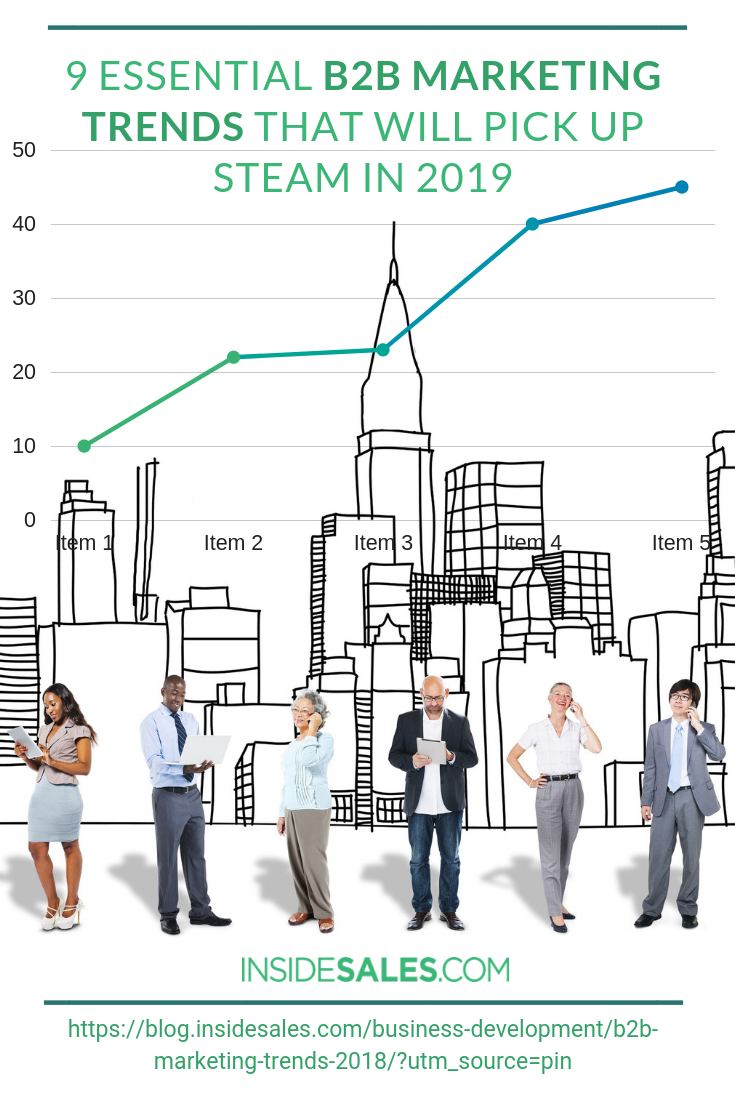9 Essential B2B Marketing Trends That Will Pick Up Steam In 2018
Gaetano DiNardi
Boost your online marketing strategies with these B2B digital marketing trends. In this post, you’ll learn which trends to utilize to boost your campaign efforts and reach your goals for the year.
RELATED: Sales Leaders: 50 Sales Trends You Need To Know About For 2019
In this article:
- Why You Need to Know the Trends
- Key 2018 B2B Digital Marketing Trends to Watch in 2018
- Where to Double Down in 2018
- Putting Things into Action in 2018
2018 B2B Digital Marketing Trends | Grow Your Online Campaign Efforts with These Ideas
Why You Need to Know the Trends
These days, marketing professionals are talking about the 2018 B2B digital marketing trends. It’s not surprising. Right now marketing teams are having their “what worked and what didn’t work” discussions. It is a perfect opportunity to reflect on emerging trends from 2018 that will continue to pick up steam in 2018.
The plain truth is B2B marketing is getting harder. Marketing SaaS exploded. Every time a new SaaS company emerges, the marketing landscape will feel the impact:
- Businesses will produce more content. (A lot of it will be awful)
- There will be even more noise on social media platforms.
- The ad blindness effect will rise on channels like Facebook and LinkedIn.
- More competitors will be bidding on the same keywords as you.
- They will be targeting the same organic keywords as you.
- More outbound emails and cold calls will target the same customers.
- There will be more leverage for review sites like G2Crowd & Capterra.
- Companies will have less differentiation in product features.
What’s the point?
CACs (Customer Acquisition Costs) are getting higher on a yearly basis. There’s less room for error on strategy and execution.
Data-driven companies master the science of analytics. They are also familiar with the art of building a personalized customer experience.
Because of these, they have the highest chances of winning.
Mistakes in 2018 will be costly. Competitors are lurking around every corner, waiting to capitalize on your failures.
That’s why we’re summarizing the top B2B marketing trends you need to know for this year. We hope this article gives you everything you need to stay ahead of the curve and win big in 2018.
Key 2018 B2B Digital Marketing Trends to Watch in 2018

Here are the key B2B digital marketing trends that will only continue to pick up steam in 2018:
1. Artificial Intelligence, Automation, and Machine Learning
Technology continues to transform the marketing world.
Some examples are email automation, higher-quality data analytics, and AI-driven solutions.
These include chatbots enhancing the sales process, one of the emerging technologies. These are bridging efficiency gaps and improving performance across the board.
Marketing automation can help assess and nurture buyers across the entire customer journey. It can do so with higher accuracy and effectiveness.
2. Continued Rise of Video Content
Text-based content is still important. Interactive formats, though, like video, are the future and the now.
Consumers are demanding richer content formats. Online video now accounts for half of all mobile traffic.
3. Stability of Content Marketing
Content marketing is here to stay and only getting bigger.
Inbound sales are now a formidable revenue-generating component in many B2B organizations.
To succeed, though, companies need to establish a healthy pipeline of high-quality content. It’s also essential to build a healthy search engine optimization (SEO) framework.
B2B organizations will still struggle with measuring the ROI of content marketing.
It’s important they do it, though. After all, they are spending a lot on content (and even content marketers).
4. Personalization via Marketing Automation
If there’s one thing you take away from this list of B2B digital marketing trends, this should be it.
You better start segmenting your email list in 2018. It should not only be divided by name or job title.
You need to consider segments with demographic data and customer life-cycle positioning. Other factors that matter are lead nurturing, and trigger-based or nudge-based messaging.
In short, it’s serving the right content to the right people at the right time.
A study from Smart Insights reveals 50% of companies use no segmentation whatsoever. That’s horrifying.
Account-Based Marketing Definition: A B2B marketing strategy wherein sales and marketing campaigns are directed and personalized for specific target accounts within the market.
5. Account-Based Marketing (ABM) Moving to the Forefront

Companies now need to provide more authentic and responsive customer engagement. Many B2B organizations, thus, now adopt account-based marketing approaches. In this graphic via Intercom, the shift to ABM highlights an inverse funnel.
Before, B2B marketers would just cast a wide net and try to build broad awareness. With ABM, it’s the opposite.
You target high-value accounts with personalized and relevant messaging. This is what it takes to cut through the noise in 2018, especially for high-value targets.
6. Fundamental Shift from Traditional to Modern SEO
Old-school tactics are long gone. These include exact-match keyword targeting and low-quality guest post link building.
With the increasing CAC, brands will be turning to more reliable channels, such as SEO.
SEO will be an everlasting source of lead generation, especially in SaaS. The rise of content marketing continues to be a major factor as well.
B2B brands will be seeking to pair that up with SEO for a mean 1-2 punch.
7. Facebook Ads
Let’s get real. One of the B2B digital marketing trends we predict is Facebook ads.
They have ridiculous targeting capabilities and affordable costs. You can get the attention of any audience segment down to the grittiest detail.
I’ll let Gary V do the talking on this one.
8. The LinkedIn Effect
After the Microsoft acquisition, LinkedIn exploded. Every B2B professional wants in on the action.
The new algorithm allows for incredible engagement with the right content.
It can benefit SaaS companies with influential leadership, so do those with a well-known company founder with a strong network.
One-line posts are what you’re going to see often in 2018, unfortunately.
9. Integration of Data Sources to Unify the Marketing Tech Stack
We wrote about this in our 2018 sales predictions, and the parallel here is uncanny. There are over 5,000 marketing SaaS vendors.
How many technologies do you think your company is using right now? Our marketing tech stack consists of 25 tools right now.
These include marketing automation, SEO, content management, and social media. We also have a platform for communication and project management, CRM, and more.
We use Google Data Studio to create unified dashboards to see all our data in one place. Plenty of integration capabilities can join all your data sources into one dashboard.
One of my personal favorites is Supermetrics, but there are many other good ones.
Data and analytics, in general, can feel overwhelming. Don’t let the fact you use all these different platforms create data silos.
Unify your stack for 2018 and get all your data on the same page.
RELATED: The Secret To Winning in B2B Sales: The Human Touch
Where to Double Down in 2018

Knowing the challenges and B2B digital marketing trends is one thing. Acting on them is another.
Here are some applicable B2B digital marketing best practices. These can help you regain lost ground and still win in 2018.
1. Ramp Up Your Content Marketing and Inbound Campaigns
Don’t ramp it up without aim, though.
Align all your content efforts back to the user journey. Make sure you’re tracking what matters!
The impact of online content on your customers’ purchasing behavior is hard to ignore. Not all content is equal, though.
High-quality content is a competitive advantage. You should always want to include it in your B2B digital marketing campaigns.
An excellent inbound marketing strategy requires the following key elements:
- A well-designed and updated website
- Timely and flawless user experiences on any device
- Lively blog that differentiates and keeps your company relevant
- Well-crafted gated content (e-books, research/reports, and white papers)
- Content that lends authority to your brand
- Frequent use of rich content formats telling a story in fresh, creative, and impactful ways
- Video content, sound, and other visuals such as Instagram Stories
- Smart SEO implementations that drive healthy traffic to your site
2. Reinforce Email Marketing with Automation and Analytics
The mailing list is among the oldest and most effective tools in a marketer’s arsenal. It lets you transition from snail-mailed catalogs to email newsletters.
In turn, this tool keeps customers aware of your brand. It also allows you to assess how your customers respond to your message.
Advanced email marketing software can help your team manage subscribers better. Options include MailChimp, Rapportive, and Yesware.
They also have the following features:
- Analyze subscriber behavior
- Schedule contextual or hierarchical content pushes
- Collect more customer information
- Build a new revenue stream via premium content
All your subscribers will show interest in your product to some degree. Even then, you can apply a more precise targeting/segmentation using email analytics.
B2B digital marketing campaigns can focus on high-value subscribers. These are individuals with the highest likelihood of buying.
3. Go Mobile and Get Social but Aim for an Omni-Channel Approach
The social selling craze wasn’t a bunch of hype.
Almost all the point persons in your prospect companies will be on social media. Decision makers are likely to maintain active LinkedIn and Twitter accounts.
Engage these point persons by following them. Respond to their posts with relevant and high-quality content.
These can create opportunities to influence their buying decisions later on.
When it comes to mobile, cell phones and tablets now serve as the primary mode of accessing the Internet. It is fast replacing desktop computers.
Mobile advertising is also on the path to achieving a similar milestone in 2018. Ad spending on mobile will surpass TV spending. The difference can be as much as $6 billion!
Mobile accounts for around 70% of people’s daily online exposure. Many smart B2C companies, thus, already adopted a mobile-first policy.
Smart Insights reported, though, desktop-based communication will remain a key channel for both transactional commerce and B2B engagements.
4. Persuade Influencers to Articulate Your Value

Popular people in different fields wield enormous social capital. They can influence wide swaths of specific market segments.
This influence extends into the purchasing behavior of their fans/followers.
Influencer marketing, thus, has become a reliable and common selling tool.
Partner with credible influencers who match your brand. Create an environment that lets them share authentic, fresh, and compelling stories.
For B2B companies, influencers will likely be subject-matter experts or industry luminaries. They may also be ranking specialists and leaders in your prospect organizations.
5. Optimize Your Tech Stack and Leverage Automation
It’s a no-brainer. Make processes easier to perform and free up time for other important tasks.
Different technology providers offer solutions to specific marketing challenges. They do this through marketing automation, data analytics, and sales enablement.
Here’s an example. You can enhance your 2018 B2B digital marketing campaigns with personalized software.
It may improve ABM, email outreach, and content management. You may also use it for market intelligence and SEO.
6. Build Your Ideal Team and Keep Them Sharp
Marketing talent remains the driving and creative force behind your team. Without the right talent, even a good strategy can flop during its implementation.
HR in many leading B2B organizations focus on hiring excellent digital marketers. They are also training or retraining them.
Don’t ignore millennials. Make sure you foster an environment millennials will thrive in.
Expertise is vital to many lean but aggressive marketing teams. A viable roster should include:
- Marketing Director — to provide vision, set directions, and manage budget
- Content Manager — to oversee all customer-facing communications
- Social media Coordinator — to boost brand presence across key networks
- SEO Specialist — to keep site traffic healthy and primed for growth
- UX/UI Designer — who can help optimize the user experience
- ROI/A-B Testing Specialist — to check metrics and make data-driven assessments/recommendations
- Web/Mobile Developer — to handle the technical components of the strategy
7. Remember, User Experience Is Still the Most Important Thing
Marketing and selling success hinge on customer decisions.
B2B companies need to understand their customers’ goals and challenges.
They need to build meaningful relationships based on that understanding. They should provide responsive customer service that addresses clients’ pain points.
Authenticity and genuine desire for a solution always trump interactions motivated by a desire to make a fast buck.
- Improve the quality and outcome of your B2B digital marketing campaigns.
- You can limit the scope of your client base. To do that, you can create a hierarchy of buyer personas.
- Sure, you want to help everyone, but your product can only solve specific problems.
- Transactions on the organizational level tend to involve a group of decision makers.
- You may need to create custom content for every buyer persona. You may also include specific rules of engagement.
Putting Things into Action in 2018
Dwelling on setbacks and what-ifs is never a good option. This is especially true in the highly competitive B2B market.
Use these B2B digital marketing trends as a guide, then build and review your post-mortem documents quickly. Optimize them to turn the odds in your favor for this year.
Doing so is not impossible, but will take a lot of work. Go beyond studying B2B marketing strategy examples. Test a few and discover which approaches move the needle.
B2B digital marketing campaigns are fluid. They now need to provide buyer journeys that are like those in the B2C environment. Focus on providing memorable experiences to your ideal customers. Upgrade content and improve process efficiencies. Optimize all engagement channels and execute a unified strategy with the sales teams.
What do you think the 2018 B2B digital marketing trends are? Share your predictions in the comments section below.
Up Next:
- How To Align Sales and Marketing
- How AI Is Disrupting Sales w/Damian O’Farrill @Autodesk
- Best Products For Sales 2019

Editor’s Note: This article was originally published on December 18, 2017, and has been updated for quality and relevancy.